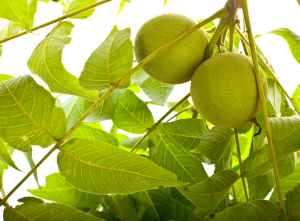[two_third last=”no”]
[title size=”2″]Black Walnut[/title]
The Black walnut tree has become one of the most popular and valuable trees in the United States due its countless and highly lucrative uses that range from medicinal to decorative purposes. Typically, black walnut trees grow to heights between 50 and 75 feet tall, but they can reach heights of 130 feet. They have a single trunk covered by a textured, grayish-brown or grayish-black bark. The Black walnut tree has alternating, feather-like leaves that change from a dark green color to yellow during the fall. The leaves are generally about 1 to 2 feet long with smaller leaflets coming out of the center of the leaf. A deciduous tree whose primary native region is the Midwest and east central United States, the Black walnut thrives best in warmer regions with fertile soil and full sunlight. They are somewhat drought-tolerant but do not grow well in soggy areas. Male flowers produce about 3-4 inch long catkins that are cylindrical with scaly buds. Female flowers produce flowering spikes. After the flowers bloom in the spring, the tree produces edible nuts. The nuts have a hard brown shell surrounded by a fleshy green covering that protects an inner nut. The fleshy green cover turns black and opens in the fall season between months of September and October. When the nut falls to the ground it is ready to be harvested. Fruiting, or producing of the nut, begins in Black walnuts at approximately 4 to 6 years old. However, it may take up 20 years for larger crops to fruit.
Black walnuts have a lifespan of about 130 years. The tree produces juglone, a substance that is toxic to other plant species such as tomatoes, azaleas, apples and potatoes. Plants affected by juglone will turn yellow and will eventually die if planted within an 80-foot range of the poisonous tree. Juglone-tolerant plants include carrots, squash, redbud and hyacinth, among others. Black walnut wood is harvested to make furniture, flooring and rifle stocks. The nutmeat is used as an ingredient in food, adding flavor to a variety of baked goods. The bark and leaves of the black walnut have astringent and laxative properties and are used in cosmetics and natural remedies.
[/two_third]
Juglans nigra
[one_third last=”yes”]
[/one_third]

